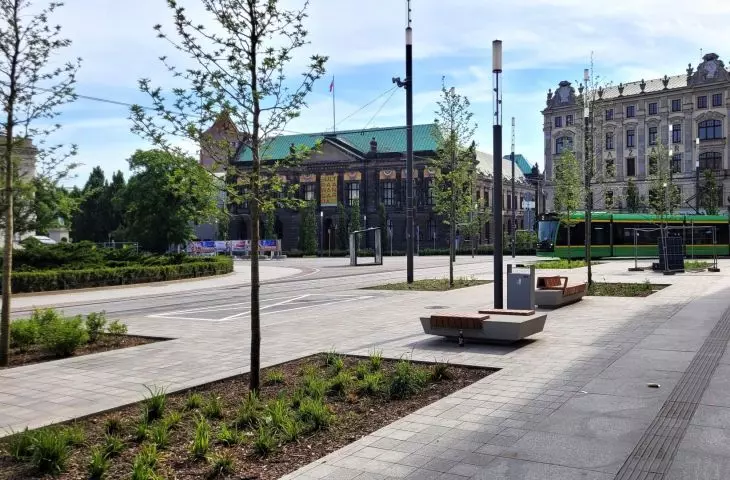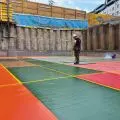Is this the finale of the major reconstruction of downtown Poznań streets? City authorities announced the completion of the much-delayed work for June this year. So we say: check, although the work is still ongoing. Basically, it is much better than before the changes and the transformed center promises to be quite good. And how did it go with the details? Maybe slowly, but sloppily. And it was only a renovation. Revitalization was lacking.
It seems that the Poznań epic called Project Center, or the transformation of the main streets of the city center, is coming to an end in pain. It all started with an architectural and urban planning competition in 2015. The task was to design the reconstruction of the degraded main street of the downtown area, i.e. St. Martin, and a more general concept for the transformation of the parallel 27 Grudnia Street and the streets connecting the two routes: Gwarna, Kantaka, Ratajczaka and a section of Marcinkowskiego Avenue. The goal was a coherent vision of a consistently planned space, so as to significantly improve the quality of the already declining center. The redevelopment was also to be part of a wide-ranging program of revitalization of the downtown. Revitalization understood as simultaneous material, social and economic renewal.
fewer cars, more trees
The winner of the one-stage competition was the project of Studio ADS of Poznań, which at the time still enjoyed a reputation gained through, among other things, the design of the Stary Browar shopping center. The head, however, was by then only Piotr Z. Barełkowski (the co-author of the studio's greatest successes, Przemyslaw Borkowicz, no longer worked at Studio ADS since 2007; both architects are now deceased). The level of the competition entries was not very high, and against their background Studio ADS' proposal looked the best. Especially since in the description the architects mentioned arranging public consultations on, for example, forms of small architecture. This gave hope for an evolutionary and socialized refinement of details.
Downtown Poznań after renovations as part of the Centrum Project - Ratajczaka Street, a board with the Centrum Project by ADS Studio and a panegyric mentioning Piotr Z. Barełkowski
photo: Jakub Glaz
The general assumptions of the winning and later detailed design included maximum traffic calming on all streets. The four asphalt lanes of the widest section of St. Martin were reduced to two. Even more restrictions were placed on car traffic along Liberty Square and on December 27 Street. Finally, a new pedestrian route connected the detached sections of Marcinkowski Avenue near Wolności Square. On all streets (with the exception of treeless Gwarna and a section of St. Martin), the number of trees was significantly increased, with an emphasis on Kantaka and Ratajczaka streets, which were previously completely devoid of them.
Downtown of Poznań after renovations under the Center Project - previously unseen extension of the pedestrian route in Marcinkowskiego Avenue, on the right: the Raczynski Library, on the left: the National Museum
photo: Jakub Głaz
The reconstruction of the streets was divided into stages. Originally they were to be finished by 2021, then the final was postponed to the following year, only to be dragged out later - during the works - until the end of 2023, and then still until this year's June (by December, instead, it was possible to start up almost all the tracks and completely restore streetcar traffic in the center).
Downtown Poznań after renovations as part of the Downtown Project - shifted tracks in 27 Grudnia Street, view toward Wolności Square
photo: Jakub Głaz
the intersection that wasn't there
The first stage covered the central part of Swiety Marcin Street and was completed in spring 2019. The result was not quite in line with the competition work, but still represented a very favorable change. Swiety Marcin ceased to be a passable noisy artery and took on the character of a tree-lined pedestrian street with a tramway (or a variation on the theme of a woonerf) supplemented only by two narrow roadways and a small number of parking spaces. Rows of mature trees were planted on wide sidewalks with a distinctive alternating pattern. However, the change of the pavement material: from stone (this was written in the competition entry) to concrete, and the paucity of low greenery plots were disappointing. Benches, trash garbage cans and bicycle racks also proved to be uncomfortable and not very sensible. We summarized the result in detail in a text from five years ago. The next phases began in 2020. First they covered the remaining parts of St. Martin's, then a section of Marcinkowskiego Avenue, and finally 27 Grudnia, Kantaka and Ratajczaka streets (here finishing work is still in progress).
Downtown Poznań after renovations under the Center Project - the middle section of Świętego Marcina near the former "Alfa" shopping and service center, the trees have grown considerably since the work was completed in 2019
Photo: Jakub Głaz
For reasons that are unclearly explained, the busy intersection of Saint Martin's and Independence Avenue next to the Castle Cultural Center was also included within the Project Center's boundaries. However, the competition did not include this area, and - despite significant improvements (a much-needed new pedestrian crossing, a new turn for the streetcar toward the station, a little more greenery) - a scaled-down road layout that contradicts the nature of the changes taking place next to it was perpetuated.
The downtown area of Poznań after renovations as part of the Center Project - a redesigned and glazed intersection of Święty Marcin Street and Al. Niepodległości, with the Academy of Music in the background
photo: Jakub Głaz
informational lull
The competition was preceded by workshops and extensive public consultations. In the first years, the City presented its intentions quite clearly and conducted a meaningful dialogue with residents. An information desk was opened, the results of the competition were shown in an open-air exhibition. The end of the openness was put to an end by the pandemic, or rather the associated possibility of extinguishing consultation and dialogue. As the work progressed, there was less and less exchange of information and more and more PR hollowness. The city did not publish projects presented in a readable manner. The website dedicated to the Center Project almost froze. The lack of dialogue culminated in the social struggle, described by us several times, to preserve the old Turkish hazel trees on December 27 Street, which , surprisingly , were to make way for new but less frequently planted plane trees. The hazel trees were saved in defiance of the City, which later allowed Mayor Jacek Jaskowiak to accuse the social side of delaying the work, unfavorable changes in the design and blame the socialists for... design errors in planning the trackway next to the iconic Okrąglak building.
Downtown Poznań after renovations under the Center Project - 27 Grudnia Street at the intersection with 3 Maja Street, in the middle: preserved Turkish hazel trees
Photo: Jakub Głaz
After Budimex, which implemented the first section of St. Martin's, the contractor for the next works was the Tormel consortium. The organization and pace of construction work deteriorated considerably, and was even disastrous at times. The information and security of the construction site was flawed, where it was often difficult to find more than a few workers. Pedestrians were lost in the maze of fences that were rearranged every now and then. The mess and thoughtlessness even became a symbol of the center's transformation, as we wrote about two years ago.
Moreover, entrepreneurs and restaurateurs isolated by the excavation and mess were offered meager support. Instead, Mayor Jaskowiak advised them to try harder and improve their offerings. Almost a year ago, he also talked about the "final straight" of the works, which, however, are only now coming to an end. And even that with an embarrassing exception. It concerns the aforementioned tracks by Okraglak. There is still no streetcar right-of-way next to it introduced by the project. This is because it turned out that it was planned on... basements protruding outside the building. Fatal recognition of the situation took revenge on the City, which led a dispute with the owner of Okraglak, and plans to add the track later. When? The magistrate's enigmatic answers explain nothing. The section above the basement has been lined with temporary slabs, fenced off and is being used as a warehouse for building material.
Downtown Poznań after renovations under the Center Project - Ratajczaka Street with new trees, low greenery plots and a completed section of the future route from the center to the Wilda district
photo: Jakub Glaz
generally everything OK
However, the overall effect of the work is, fortunately, much better than the way it was carried out. The general assumptions of traffic calming, increasing the share of greenery, widening sidewalks and giving the downtown a coherent expression of the space between buildings have been fulfilled. On the plus side, there are stone pavements, sensible lighting, previously non-existent rows of trees, and a much greater number of benches and other street furniture. Food gardens, which once had no place at all, have already grown into the landscape of the previously finished sections of the streets. The center, shaped in this way, promises to be quite promising, and in the future it may become very profitable to run a restaurant, store or service here.
Downtown Poznań after renovations as part of the Downtown Project - the narrowest section of Saint Martin's Street with trees in pots and without a bicycle contraflow lane
Photo: Jakub Głaz
And what will it be like to live in the center? Street reconstruction has already been followed by major renovations of several private tenements, which is, of course, beneficial, but will probably affect rents and the social cross-section of tenants. Indeed, there has been a major renovation of a section of the city, but no real revitalization that fully engages, supports and protects local communities. Thus the specter of unrestricted gentrification looms in the horizon.
Downtown of Poznań after renovations under the Centrum Project - a newly renovated building of a former school (later a branch of the Raczynski Library) on Swiety Marcin St.; developer apartments are to be built there.
photo: Jakub Glaz
And one more thing: the long-term effects will be influenced by the level of maintenance and upkeep of the transformed streets, as well as the quality of the work done. Meanwhile, the redeveloped center of Poznań is currently extremely dirty, with defects being fixed after a long time or not at all. The city center clearly lacks a consistent host and a system for managing the renewed space. Especially since - when we look at the details and the not-so-high quality of the work done - such activities are not limited to cleaning and greenery maintenance. It is therefore time to take a closer look at the various aspects of the transformation.
Downtown Poznań after renovations under the Center Project - the edge of the bus stop on Ratajczaka Street
photo: Jakub Głaz
pavements
Subsequent stages of the redevelopment of Saint Martin 's succeeded in restoring the "stone" in the form of granite slabs and pavers written in the competition work. The pattern of the sidewalks is thus the same, but of a nobler and easier-to-clean material. Other, with a calmer expression, are the stone surfaces of the roadways (in the central section of Saint Martin's the roadways have almost the same pattern as the sidewalks).
Downtown Poznań after renovations as part of the Downtown Project - a rather peculiarly made junction of stone (top) and concrete (bottom) sidewalk surfaces on Swietym Marcinie
Photo: Jakub Głaz
At the junction of Aleje Marcinkowskiego and Świętego Marcin, however, the galimatias begin. On one side of Swiety Marcin, behind Piekary Street, the "historic" pavement pattern typical of the Old Town suddenly begins. On the other - the distinctive new pattern "turns" instead with an excess into the Avenues and only ends at the exit of Podgórna Street. In turn, the road surfaces of the Avenues were lined with crooked old cobblestones. The result: walking from the Old Market to Liberty Square, pedestrians (including people with disabilities) and cyclists suddenly find themselves on uneven sections that could have been sanded down without harming the visual effect (there are already many such good examples in the city).
Downtown Poznań after renovations under the Center Project - a crossing and bicycle passage between Old Market Square and Liberty Square (the fountain in the square is visible); pedestrians and cyclists have to cross the uneven pavement of the roadway
Photo: Jakub Głaz
An abrupt and ill-considered confluence of the two orders has also been fabricated by the designers at the intersection with Kosciuszko Street. This exceptional awkwardness in combining several different types of sidewalk is reportedly the result of a tug-of-war with the Office of the City Historic Preservation Officer. Apparently, because, as we mentioned, the city authorities have not been slow to officially explain to residents what is being done a certain way, how and why.
Downtown Poznań after renovations under the Center Project - an accidentally designed junction of new and old type pavement at the intersection of Święty Marcin and Kościuszki streets
photo: Jakub Głaz
The sidewalks and bicycle paths along Wolności Square and on 27 Grudnia Streetare much more consistently laid out. Medium-sized stone pavers and granite slabs create a more traditional and consistent layout along the entire length of this section. It's only worse at the junction with Ratajczaka and Kantaka Streets, which feature a contemporary pattern, the same as on Swiety Marcin.
Downtown Poznań after renovations under the Center Project - south side of Wolnosci Square, new plane trees and low greenery, view towards the west
Photo: Jakub Głaz
small architecture
Concrete consistency, on the other hand, was shown by the designers in the case of the benches. Despite the fact that - already after the first stage of work - concrete blocks with small seats attached to them were criticized, they were placed almost in the entire project area. It only succeeded in forcing a change in the material from which the not very comfortable seats were made. The gray plastic was replaced with wood, for which a plus is due. Worse, the varnish is already coming off the wood. The concrete remains. It's also a good thing that no more photovoltaics with USB connections were installed on the following benches. These gadgets can still be seen on the first section of St. Martin. If they worked, it was only for the first weeks. Only on 27 Grudnia Street were more comfortable, though not as "designer" as typical city benches - without concrete, but able to be sat on in full, not just partially.
Downtown Poznań after renovations under the Center Project - new benches of two types side by side, on the left - stalls of highlanders
photo: Jakub Głaz
Trash garbage cans and bicycle racks: here we have a mix of forms from the first part of the project and catalog urban solutions in the next. Giving up rachitic racks and single low-volume garbage cans makes perfect sense (the competition entry promised garbage cans with waste segregation!). It's a pity that the next phases also did not forgive the drinkers, which on St. Martin usually do not work and are treated as ashtrays.
Downtown Poznań after renovations under the Center Project - a non-working watering can that usually serves as an ashtray
photo: Jakub Głaz
Perhaps the mistakes described above could have been avoided if , according to the competition entry , the small architecture had been designed "individually with high-quality materials and in consultation with residents." Are plastic, concrete and easily bent bicycle racks "high quality materials"? Why was there a lack of consultation? The magistrate never gave a clear answer on this issue.
Downtown Poznań after renovations under the Downtown Project - dirty and non-functional benches/seats on Swiety Marcin Street
photo: Jakub Głaz
Lighting was the most consistent and sensible. With the exception of Gwarna Street (here the lamps were strung between buildings), all streets have the same simple lanterns in the form of slender cylinders of two heights. They have a timeless and neutral appearance, they calm the downtown space and emit an appropriate, not too much light. However, it is too cold, and when replacing the LEDs in the future, care should be taken to change them to a warmer color (such a move was recently made by the City on Taczak Street, which was rebuilt five years ago). It's also worth adjusting the spotlights in the luminaires so that they don't illuminate the walls of the buildings. The floor water features in the Saint Martin's sidewalk also need final adjustment. Sometimes, instead of water, they only emit loud hisses.
Downtown Poznań after renovations under the Center Project - a row of new streetlights in 27 Grudnia Street
Photo: Jakub Głaz
greenery
Issues of greenery aroused emotions already after the first stage of the works. For, although more than 60 new trees were planted in the central section of St. Martin's, low and more diverse greenery was missing (instead, unfortunate, too massive concrete pots appeared). And yet, in the competition entry, the designers envisioned, for example, a "recreational urban garden" as one of the modules for developing the wide sidewalk. Also controversial was the planting of trees in special chambers, which is supposed to prevent the collision of roots with the infrastructure and support the development of the tree, which, however, requires more care. A wide sidewalk without shrubs or flowers launched a narrative of concretization.
Downtown Poznań after renovations as part of the Downtown Project - a well-composed and well-maintained greenbelt with new trees on Święty Marcin Street between Gwarna and Kościuszki Streets
photo: Jakub Głaz
Subsequent phases went better, except for a narrow section of Swiety Marcin (between Ratajczaka and Piekary streets), where there are no trees in the ground, and pots reign supreme. Gwarna Street (otherwise the most dilapidated and neglected of the Project's streets) also has a deserted character, with very little low greenery as well. A very positive change has taken place along Liberty Square, where trees were previously absent, but now feature a double row of plane trees. Here, as well as on December 27 Street (unlike on Swieto-Martin), new trees and preserved Turkish hazel grow in large, now greened platanus plots. The greened new pedestrian section of Marcinkowskiego Avenue, a new square with benches at the intersection of 27 Grudnia and 3 Maja Streets, a flowered circle with a single tree (as a solitary) in front of Okrąglak, and green belts along the tracks on Swiety Marcin were also very attractive.
Downtown Poznań after renovations as part of the Downtown Project; a square at the intersection of 3 Maja and 27 Grudnia streets in place of a scaled-down roadway
New trees and low greenery also positively enliven Kantaka and Ratajczaka streets, as well as the western section of St. Marcin (it would benefit from another row of trees at the intersection with Kosciuszko Street). After perturbations with Turkish hazel trees, the City unfortunately abandoned the planned second row on December 27 Street. The reason is said to be, among other things, collisions with underground infrastructure, which seems a bizarre explanation in a project done entirely from scratch. And, of course, according to the City, the change is blamed on the public. On the other hand, the semi-open courtyard in front of CK Zamek, which was to be a treeless "event plaza," has been excluded from the Center Project and will get a free green setting in line with the design selected in a separate 2019 competition (designed by Aleksander Wadas, currently under reconstruction).
Downtown Poznań after renovations under the Center Project - a new decorative greenbelt and oak trees along Marcinkowskiego Avenue, with the Raczynski Library at Wolnosci Square in the background, (National Museum behind the frame - on the right)
Photo: Jakub Głaz
communication
The general assumptions of the project have been implemented, most streets are covered by a residential zone, traffic has been significantly calmed down. A new, previously non-existent track on a section of Ratajczaka Street has been created, which will eventually be connected with the planned route further down the street, leading to the Wilda district (it could not be realized due to lack of finances). For now, vintage streetcars start from the "blind" track on weekends. Compared to the project, the space in front of CK Zamek has been slimmed down by one roadway.
Downtown of Poznań after renovations under the Center Project - turning of the new route from Ratajczaka Street (left) into 27 Grudnia Street
photo: Jakub Głaz
However, there has been a key and very unfavorable change in Marcinkowskiego Avenue, where a short section between Swietego Marcin and Podgórna streets was supposed to be impassable, which would have effectively curbed car transit through the center. For unclear reasons, the traffic was maintained, resulting in traffic jams on Swietego Marcin and Avenues during rush hour. The change has also muddled up solutions for cyclists, which the entire Downtown Project rates average at best. The barely intuitive and - fortunately, only in places - downright bizarre routing of bicycle routes could not be modified even by the usually effective activists of the Bicycle Poznań association. They also half-heartedly succeeded in doing so in the area of the aforementioned scaled-down intersection of St. Martin and Niepodległości Avenue (in one place, they even increased the number of lanes for cars from three to four!).
Downtown Poznań after renovations under the Center Project - illogical layout of roads and bicycle lanes at Mickiewicza Square
Photo: Jakub Głaz
quality of workmanship
Those who still live by the myth of "Poznan solidity" will sober up after looking at the not very carefully laid slabs and p avers (not enough even pavement, pattern shifts), numerous cracks and ways of installing small architecture elements. The work has been done sloppily in many places, and endless corrections are underway (including removing the entire sidewalk in front of the Polish Theater and laying it anew).
Downtown Poznań after renovations under the Center Project - quality of paving work
photo: Jakub Glaz
There was also the dismantling of an already laid turnout for bicycles and laying it according to a new design, as well as the hasty... cutting of the edge of the stop, which was snagged by one type of streetcar. One can only hope that Poznań Municipal Investments, which is responsible for the Center Project, will see to it that the contractor corrects everything. The only question that arises is how long it will take him. Will we count it in months or years?



















































































































































